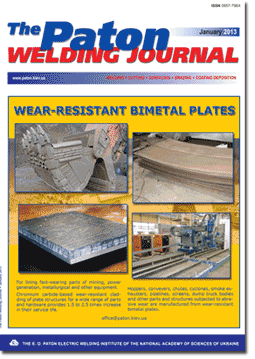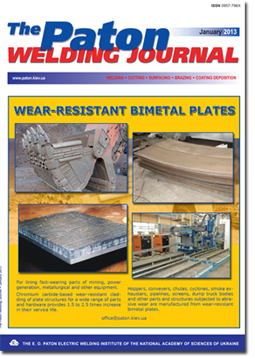| 2013 №01 (05) | 2013 №01 (07) |

The Paton Welding Journal, 2013, #1, 28-30 pages
EFFECT OF FRICTION WELDING PARAMETERS ON STRUCTURE AND MECHANICAL PROPERTIES OF JOINTS ON TITANIUM ALLOY VT3-1
A.G. SELIVERSTOV1, Yu.M. TKACHENKO2, R.A. KULIKOVSKY2, V.I. BRAGINETS3 and I.V. ZYAKHOR4
1OJSC «Motor Sich», Zaporozhie, Ukraine
2Zaporozhie National University of the Ministry of Education and Science of Ukraine, Zaporozhie, Ukraine
3Zaporozhie Research-Engineering Centre for Plasma Technologiesof the E.O. Paton Electric Welding Institute, NASU, Zaporozhie, Ukraine
4E.O. Paton Electric Welding Institute, NASU, Kiev, Ukraine
Abstract
The study presents investigation results on formation of joints in friction welding (FW) of titanium alloy VT3-1, which is used in structure of axial-flow compressors of aircraft gas turbine engines (GTE). The purpose of the study was to optimise parameters of FW of alloy VT3-1, based on the possibility of its implementation by using modern equipment for linear friction welding (LFW) in order to manufacture and repair GTE monowheels, i.e. the so-called blisks. Optimal values of the FW parameters were determined on the basis of results of mechanical tensile tests, metallographic examinations and measurements of microhardness of the welded joints produced by FW in air and in shielding gas atmosphere (argon). It was established that in FW of alloy VT3-1 the sound (defect-free) joints can be produced over a wide range of variations in the process parameters, providing that the specified value of the total length loss in welding in ensured. Strength values of the joints exceed those of the base metal of alloy VT3-1. As a result of intensive thermomechanical deformation at temperatures above the b-transus temperature of alloy VT3-1 and rapid cooling after FW, the joining zone metal has a dynamically recrystallised fine-grained structure and increased hardness. Based on the results obtained, the FW parameters were optimised for alloy VT3-1 at a comparatively low linear velocity of relative motion of the billets, which is feasible in LFW of titanium alloys by using the existing equipment. 22 Ref., 1 Table, 6 Figures.
Keywords: friction welding, titanium alloys, mechanical properties, full strength, welding parameters
Received: 14.06.12
Published: 28.01.12
References
1. Tretiakov, V.E. (1968) Fusion welding of titanium and its alloys. Moscow: Mashinostroenie.
2. Lebedev, V.K., Chernenko, I.A., Vill, V.I. et al. (1987) Friction welding: Refer. Book. Leningrad: Mashinostroenie.
3. Bolshakov, M.V., Chernitsyn, A.I. (1974) Structure and properties of OT4 titanium alloy joints made by friction welding. Svarochn. Proizvodstvo, 7, 40-42.
4. Eichhorn, F., Kes, P., Maser, D. (1990) Gefuegeausbildung und Eigenschaften artgleicher Reibschweissverbindungen aus Titanwerkstoffen. Schweissen und Schneiden, 42(4), 189-191.
5. Bohm, K.-H., Ventzke, V., Kocak, M. et al. (2003) Parameter study into the friction welding of the intermetallic TiAl and the alloy Ti6Al4V. Welding and Cutting, 2, 90-96.
6. Nessler, C.G., Rutz, D.A., Eng, R.D. et al. (1971) Friction welding of titanium alloys. Welding J., 50(9), 379-385.
7. Attallah, M.M., Preuss, M., Boonchareon, C. et al. (2012) Microstructural and residual stress development due to inertia friction welding in Ti-6246. Metallurg. and Mat. Transact. A, 43(9), 3149-3161.
8. Schwartz, M.M. (1985) Inertia friction welding of helicopter components. In: DVS Lectures of 2nd Int. Conf. on Welding and Brazing in Aircraft and Spacecraft Construction (Essen, Sept. 16-17, 1985), 36-43.
9. Threadgill, P.L., Russell, M.J. (2007) Friction welding of near shape performs in Ti-6Al-4V. In: Proc. of 11th World Conf. on Titanium Science and Technology (Kyoto, Japan, June 3-7, 2007), 1283-1286.
10. Shtrikman, M.M. (2008) Linear friction welding. Svarochn. Proizvodstvo, 12, 35-40.
11. Vairis, A., Frost, M. (1998) High frequency linear friction welding of a titanium alloy. Wear, 217(4), 117-131.
12. Wilhelm, H., Furian, R., Moloney, K.C. (1996) Linear friction bonding of titanium alloys for aeroengine application. In: Proc. of 8th World Conf. on Titanium Science and Technology (Birmingham, UK, 22-26 Oct. 1995).
13. Tie-jun, S., Dong-gang, S., Yong, Z. et al. (2009) Mechanical properties and microstructure of linear friction welded TC4 + TC17 joint. J. Aeronaut. Materials, 29(4), 33-37.
14. Wanjara, P., Jahazi, M. (2005) Linear friction welding of Ti-6Al-4V: Process, microstructure and mechanical property interrelationships. Metallurg and Mat. Transact. A, 36(8), 2149-2164.
15. Vairis, A., Frost, M. (2000) Modeling the linear friction welding of titanium blocks. Material Sci. and Eng. A, 292, 8-17.
16. Vairis, A., Frost, M. (1999) On the extrusion stage of linear friction welding of Ti6Al4V. Ibid., 271, 477-484.
17. Vairis, A., Frost, M. (2006) Design and commissioning of a friction welding machine. Materials and Manufact. Proc., 21, 766-773.
18. Zyakhor, I.V. (2001) Modern equipment for friction welding. The Paton Welding J., 7, 48-52.
19. GOST 19807-91: Titanium and wrought titanium alloys. Grades. Instead of GOST 19807-74. Introd. 17.07.91. Moscow: Standart.
20. Akimova, A.Yu., Arzamasov, B.N., Arutyunova, I.A. et al. (1976) Reference book of metalist. Vol. 2. Moscow: Mashinostroenie.
21. Brun, M.Ya. (1971) Influence of phase composition on thermomechanical strengthening of (a + b)-titanium alloys. Tsvet. Metally, 12, 53-56.
22. Gurevich, S.M., Zamkov, V.N., Blashchuk, V.E. et al. (1986) Metallurgy and technology of welding of titanium and its alloys. Kiev: Naukova Dumka.
Suggested Citation
A.G. SELIVERSTOV1, Yu.M. TKACHENKO2, R.A. KULIKOVSKY2, V.I. BRAGINETS3 and I.V. ZYAKHOR4 (2013) EFFECT OF FRICTION WELDING PARAMETERS ON STRUCTURE AND MECHANICAL PROPERTIES OF JOINTS ON TITANIUM ALLOY VT3-1. The Paton Welding J., 01, 28-30.The cost of subscription/purchase order journals or individual articles
| Journal/Currency | Annual Set | 1 issue printed |
1 issue |
one article |
| TPWJ/USD | 384 $ | 32 $ | 26 $ | 13 $ |
| TPWJ/EUR | 348 € | 29 € | 24 € | 12 € |
| TPWJ/UAH | 7200 UAH | 600 UAH | 600 UAH | 280 UAH |
| AS/UAH | 1800 UAH | 300 UAH | 300 UAH | 150 UAH |
| AS/USD | 192 $ | 32 $ | 26 $ | 13 $ |
| AS/EUR | 180 € | 30 € | 25 € | 12 € |
| SEM/UAH | 1200 UAH | 300 UAH | 300 UAH | 150 UAH |
| SEM/USD | 128 $ | 32 $ | 26 $ | 13 $ |
| SEM/EUR | 120 € | 30 € | 25 € | 12 € |
| TDNK/UAH | 1200 UAH | 300 UAH | 300 UAH | 150 UAH |
| TDNK/USD | 128 $ | 32 $ | 26 $ | 13 $ |
| TDNK/EUR | 120 € | 30 € | 25 € | 15 € |
AS = «Automatic Welding» - 6 issues per year;
TPWJ = «PATON WELDING JOURNAL» - 12 issues per year;
SEM = «Electrometallurgy Today» - 4 issues per year;
TDNK = «Technical Diagnostics and Non-Destructive Testing» - 4 issues per year.


